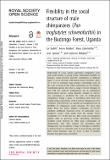Files in this item
Flexibility in the social structure of male chimpanzees (Pan troglodytes schweinfurthii) in the Budongo Forest, Uganda
Item metadata
| dc.contributor.author | Badihi, Gal | |
| dc.contributor.author | Bodden, Kelsey | |
| dc.contributor.author | Zuberbühler, Klaus | |
| dc.contributor.author | Liran, Samuni | |
| dc.contributor.author | Hobaiter, Cat | |
| dc.date.accessioned | 2022-11-11T08:30:11Z | |
| dc.date.available | 2022-11-11T08:30:11Z | |
| dc.date.issued | 2022-09-28 | |
| dc.identifier | 281226189 | |
| dc.identifier | 18d20cf6-0f2a-4a5e-9a7a-12ec22f83fac | |
| dc.identifier | 36177197 | |
| dc.identifier | 85140853282 | |
| dc.identifier.citation | Badihi , G , Bodden , K , Zuberbühler , K , Liran , S & Hobaiter , C 2022 , ' Flexibility in the social structure of male chimpanzees ( Pan troglodytes schweinfurthii ) in the Budongo Forest, Uganda ' , Royal Society Open Science , vol. 9 , no. 9 , 220904 . https://doi.org/10.1098/rsos.220904 | en |
| dc.identifier.issn | 2054-5703 | |
| dc.identifier.other | ORCID: /0000-0001-8378-088X/work/122719760 | |
| dc.identifier.other | ORCID: /0000-0002-3893-0524/work/122719784 | |
| dc.identifier.uri | https://hdl.handle.net/10023/26372 | |
| dc.description | C.H. and G.B. received funding from the European Union's 8th Framework Programme, Horizon 2020, under grant agreement no. 802719. | en |
| dc.description.abstract | Individuals of social species experience competitive costs and social benefits of group living. Substantial flexibility in humans' social structure and the combination of different types of social structure with fission–fusion dynamics allow us to live in extremely large groups—overcoming some of the costs of group living while capitalizing on the benefits. Non-human species also show a range of social strategies to deal with this trade-off. Chimpanzees are an archetypical fission–fusion species, using dynamic changes in day-to-day association to moderate the costs of within-group competition. Using 4 years of association data from two neighbouring communities of East African chimpanzees (Pan troglodytes schweinfurthii), we describe an unexplored level of flexibility in chimpanzee social structure. We show that males from the larger Waibira community (N = 24–31) exhibited additional structural levels of semi-stable core–periphery society, while males from the smaller Sonso community (N = 10–13) did not. This novel core–periphery pattern adds to previous results describing alternative modular social structure in other large communities of chimpanzees. Our data support the hypothesis that chimpanzees can incorporate a range of strategies in addition to fission–fusion to overcome costs of social living, and that their social structures may be closer to that of modern humans than previously described. | |
| dc.format.extent | 20 | |
| dc.format.extent | 1265573 | |
| dc.language.iso | eng | |
| dc.relation.ispartof | Royal Society Open Science | en |
| dc.subject | Sociality | en |
| dc.subject | Social network analysis | en |
| dc.subject | Fission-fusion | en |
| dc.subject | Primate | en |
| dc.subject | Ranging | en |
| dc.subject | Group-living | en |
| dc.subject | QL Zoology | en |
| dc.subject | RC0321 Neuroscience. Biological psychiatry. Neuropsychiatry | en |
| dc.subject | DAS | en |
| dc.subject.lcc | QL | en |
| dc.subject.lcc | RC0321 | en |
| dc.title | Flexibility in the social structure of male chimpanzees (Pan troglodytes schweinfurthii) in the Budongo Forest, Uganda | en |
| dc.type | Journal article | en |
| dc.contributor.sponsor | European Research Council | en |
| dc.contributor.institution | University of St Andrews. Centre for Social Learning & Cognitive Evolution | en |
| dc.contributor.institution | University of St Andrews. School of Psychology and Neuroscience | en |
| dc.contributor.institution | University of St Andrews. Institute of Behavioural and Neural Sciences | en |
| dc.identifier.doi | 10.1098/rsos.220904 | |
| dc.description.status | Peer reviewed | en |
| dc.identifier.grantnumber | 802719 | en |
This item appears in the following Collection(s)
Items in the St Andrews Research Repository are protected by copyright, with all rights reserved, unless otherwise indicated.

